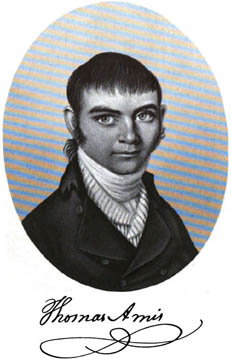CTA :: Capt Thomas Amis History
When the Marquis de Lafayette withdrew from the French Military service in 1771 to help the American patriots, there followed a great surge of interest in the American cause. The French, who had bitterly fought against the English in America, now espoused the principles of the revolution and joined with them. Thomas Amis (pronounced amy) was one of these. According to the writings of Dr. George E. Mellon of the University of Tennessee, “In his day, Thomas Amis was a man both of substance and official distinction.” On December 22, 1776, he was appointed Commissary for the Third regiment, North Carolina Continental Troops, under Colonel Jethro Sumners.
Given the rank of Captain, he was to consider ways and means of bringing Tories to justice during the Revolutionary War. As procurer of supplies it was his job to fit the soldiers with shoes, clothes, food, ammunition, and whatever else they needed, even to the extent of mortgaging his own farm, which he did. But after hiding the “Swamp Fox” (Francis Marion) and his band of soldiers at his mill on Drowning Creek (Bladen Co., NC) Amis’ bravery and willingness to help in the cause of freedom would establish him as a marked man. And so, under cover of darkness and in the protection of the Continental troops he was able to remove his family, household goods and wagons out of harm’s way before the British confiscated his property. In the latter part of the 1700s the family crossed the Appalachians and settled on Big Creek where Tom had been granted 1000 acres for his military service.
Having served as Captain of a Commissary outfit during the war, he was determined to make use of his experiences by opening a frontier Inn in the East Tennessee country (North Carolina at that time). And so he did. The Captain himself often greeted dusty travelers who rode on horseback or walked up the hill to the Amis Inn at the gate. Surrounded by a log palisade his gray stone home and store crowned the crest of the eminence. The upper part of the house was barely visible above the pointed ends of the weather-blackened logs. Once inside, visitors found themselves in a bustling community. The clang of iron on iron at the blacksmith shop and the twang of axe on grindstone greeted their ears. Inside the big stone house on the knoll they might refresh themselves with a glass of grog and eat food prepared in the outdoor kitchen. Here they could rest overnight, buy bacon, cheese and all manner of clothing to fit them for their journey.
Known house guests included Andrew Jackson, Dr. Thomas Walker, Surveyor/Explorer, Bishop Francis Asbury, Founder of the Methodist religion in America, Gov. John Sevier, Daniel Boone, Botanist Andre Michaux who wrote of the Amis home in his diary in 1790 and spoke of its beauty; Capt William Walton who would construct a road from East Tennessee to Nashville. The Amis home became the stopping point for nearly every traveler who passed through this part of the country and wanted a roof over their heads in the 1700s. Thomas Amis was a man who went around building doors for opportunity to knock on. He was fiercely loyal to his friends, he fought for freedom, he loved his country, he was a Patriot… and this writer is proud to call him my 5th great-grandfather.
Signed – Wendy JacobsAMIS :: Capt Thomas Amis & Amis Home

